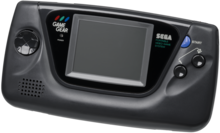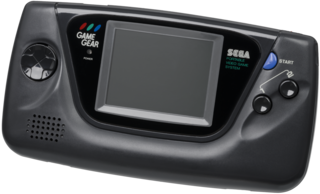
The Game Gear is an 8-bit fourth generation handheld game console released by Sega on October 6, 1990, in Japan, in April 1991 throughout North America and Europe, and during 1992 in Australia. The Game Gear primarily competed with Nintendo's Game Boy, the Atari Lynx, and NEC's TurboExpress. It shares much of its hardware with the Master System, and can play Master System games through the use of an adapter. Sega positioned the Game Gear, which had a full-color backlit screen with a landscape format, as a technologically superior handheld to the Game Boy.
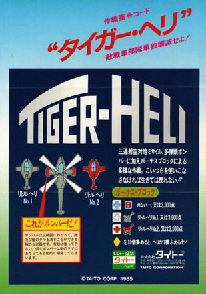
Tiger-Heli is a vertically scrolling shooter game developed by Toaplan and released for arcades in 1985. It was published in Japan by Taito and in North America by Romstar. Controlling the titular attack helicopter, the player must fight endless waves of military vehicles while avoiding collision with their projectiles and other obstacles. The Tiger-Heli has a powerful bomb at its disposal that can clear the screen of enemies when fired. It was the first shoot 'em up game from Toaplan, and their third video game overall.
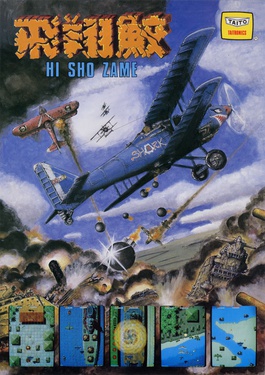
Flying Shark, known as Sky Shark in North America, is a 1987 vertically scrolling shooter arcade video game originally developed by Toaplan and published by Taito in Japan, Romstar in North America and Electrocoin in Europe. Controlling the titular biplane, the players must fight endless waves of military vehicles while avoiding collision with their projectiles and other obstacles. The plane has a powerful bomb at its disposal that can clear the screen of enemies when fired. It was the third shoot 'em up game from Toaplan, and their eighth video game overall.
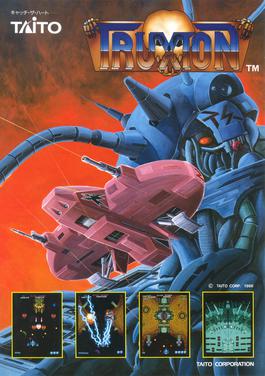
Truxton is a 1988 vertically scrolling shooter arcade video game originally developed by Toaplan and published in Japan and Europe by Taito, as well in North America by Midway. Set in a future where the Gidans alien race led by Dogurava invaded the fictional planet Borogo, players assume the role of fighter pilot Tatsuo taking control of the Super Fighter ship on a last-ditch effort to overthrow the alien invaders.
Manabu Namiki is a Japanese video game composer who is primarily known for his work in shoot 'em up games. He has worked with game companies such as Allumer, NMK, Raizing and Cave. In October 2002, Namiki, Hitoshi Sakimoto, and Masaharu Iwata founded Basiscape. The trio had worked for NMK for sound production under the title "Santarou" before the employment, so he started to assume the handle when appearing on the chiptune scene and performed live at the Japan Chiptune Tour 2004. He is currently the sound director at M2.
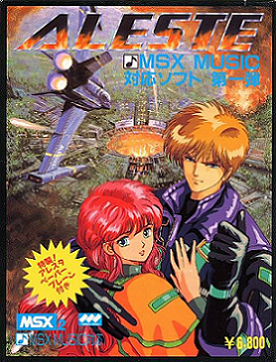
Aleste (アレスタ) is a vertically scrolling shooter developed by Compile, originally published by Sega in 1988 for the Master System and then by CP Communications for the MSX2. The Master System version was released outside Japan as Power Strike. The game spawned the Aleste and Power Strike franchises.

Valis III is a 1990 action-platform video game originally developed by Laser Soft, published by Telenet Japan and NEC for the TurboGrafx-CD. A Sega Genesis version was released in 1992. It is the third entry in the Valis series. It stars Yuko Asou, a Japanese teenage schoolgirl chosen as the Valis warrior and wielder of the mystical Valis sword after the events of Valis II. King Glames, wielder of the sword Leethus, leads denizens of the dark world to conquer both Vecanti and Earth, seeking refuge for his people amid the destruction of their planet. Together with the demon warrior-maiden Cham and her sister Valna, Yuko must prevent Glames from destroying both worlds. Through the journey, the player explores and searches for items and power-ups while fighting enemies and defeating bosses.

Gley Lancer is a 1992 scrolling shooter video game originally developed by NCS Corporation, published in Japan by Masaya and in South Korea by Samsung for the Sega Mega Drive/Genesis. It was re-released in 2019 by Japanese publisher Columbus Circle. It follows Lucia Cabrock, daughter of Earth Federation Navy admiral Ken, who disappeared while fighting in a war between humans and an unknown alien race that possess the ability to teleport, joined by her friend Teim on a journey to save her father by stealing a starfighter. Controlling the titular fighter ship, the player must fight waves of enemies and bosses, while avoiding collision with their projectiles and other obstacles. The Gley Lancer ship is equipped with two satellites options, whose positions and formations are determined by the player.
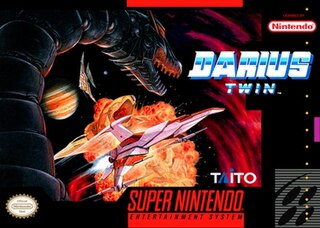
Darius Twin is a 1991 horizontal-scrolling shooter video game developed and published by Taito for the Super Nintendo Entertainment System. It is part of the Darius series. It was re-released on the Wii Virtual Console in 2010 for Japan on April 13 and for North America on December 13.

Valis II is a 1989 action-platform video game originally developed by Laser Soft, published by Telenet Japan and NEC for the PC Engine CD-ROM²/TurboGrafx-CD. A home computer version was released for PC-8801, MSX2, PC-9801 and X68000. A super deformed-style remake was also released in 1992 for the Sega Mega Drive/Genesis. It is the second entry in the eponymous series. It stars Yuko Asou, a Japanese schoolgirl teenager chosen to become the Valis warrior by wielding the titular mystical sword, after defeating the demon lord Rogles. The dream world Vecanti fell under the rule of emperor Megas, whose hatred towards his brother Rogles and bloodthirsty tendencies seeks to wipe out traces of the former tyrant, including his supporters. Gameplay varies between each version but all share similar elements, as the player explores and search for items and power-ups, while fighting enemies and defeat bosses.

MUSHA is a vertically scrolling shooter developed by Compile and released for the Sega Genesis in 1990. An entry in Compile's shooter series, Aleste, MUSHA places the player in the role of a flying mecha pilot who must destroy a large super intelligent computer threatening planet Earth. The game had a working title of Aleste 2 and originally featured a style similar to the first game, but this was changed to a more original Japanese aesthetic and speed metal soundtrack.

Truxton II is a 1992 vertically scrolling shooter arcade video game originally developed and published by Toaplan in Japan and Europe. It is the sequel to Truxton, which was released earlier on arcades in 1988 and later ported to various platforms.

Sorcer Striker is a 1993 vertically scrolling shooter arcade video game developed by Raizing and published in 1993 by Able Corporation in Japan and Europe. In the game, players assume the role from one of the four bounty hunters to overthrow the Goblin empire led by King Gobligan and reclaim the bounty placed by King Codwenna of Violent Kingdom over Gobligan's head. It is the first entry in the Mahō Daisakusen trilogy, which includes Kingdom Grand Prix and Dimahoo, and the first video game to be created by Raizing.

M2 Co., Ltd. is a Japanese video game developer and publisher, best known for handling emulation of re-released games, such as some Sega Ages titles, Virtual Console titles for Nintendo systems, the 3D Classics series for the Nintendo 3DS and their ShotTriggers range of classic STG games. M2 has also created entirely new titles such as WiiWare games for Konami under the ReBirth moniker and more recently a new GG Aleste game. In addition, M2 currently holds the rights of Aleste series and all NEC Avenue and NEC Interchannel games on TurboGrafx-16 and variants, previously owned by Lightweight.
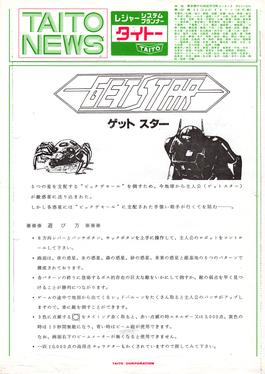
Guardian is a 1986 side-scrolling beat 'em up arcade video game developed by Toaplan and published in Japan by Taito and North America by Kitkorp. In the game, players assume the role of a robot fighting against a multitude of enemies and bosses across six locations on a futuristic science fiction setting. It is notable for marking the debut of Twin Cobra and Hellfire artist Kōetsu Iwabuchi in the video game industry, serving as its graphic designer.

Clockwork Aquario is a platform game developed by Westone and published by ININ Games for the Nintendo Switch and PlayStation 4. The gameplay involves defeating waves of enemies, picking up power-ups and items, and destroying bosses across multiple levels to stop Dr. Hangyo from taking over the world.

Seirei Senshi Spriggan is a 1991 vertically scrolling shooter video game developed by Compile and published by Naxat Soft in Japan for the PC Engine CD-ROM². In the game, the player assume control of Jega and Rikart piloting the Spriggan in order to protect their country from the Buraizubara empire.

Power Strike II is a 1993 vertically scrolling shooter video game developed by Compile and published by Sega. Part of the Aleste series, the game takes place across the seas and skies near Italy during the 1930s, with the player assuming the role of a Pothunter piloting the Falcon Flyer aircraft to shoot down sky pirates, former pilots that turned to air piracy for survival as result of the great depression in 1929. It retains the same gameplay conventions as the original Power Strike, with the player fighting endless waves of enemies while avoiding collision with their projectiles and other obstacles.

GG Aleste is a 1991 vertically scrolling shooter video game developed and published by Compile for the Game Gear. An entry in the Aleste series, the game follows Ellinor Waizen piloting the Galvanic Gunner space fighter craft to face against the invading Moon Child army. Its gameplay follows the same conventions as earlier Aleste titles, with the player fighting waves of enemies and bosses, while avoiding collision with their projectiles and other obstacles.

Power Strike II is a 1993 vertically scrolling shooter video game developed by Compile and published by Sega for the Game Gear. An entry in the Aleste series, it is a follow-up to GG Aleste (1991). The game follows Alice Waizen piloting the Lance Bird space fighter craft to stop an unknown parasitic object attached to the armored defense satellite Algo. Its gameplay is similar to the previous Aleste entry on Game Gear, with the player fighting enemies and bosses, while avoiding collision with their projectiles and other obstacles.


